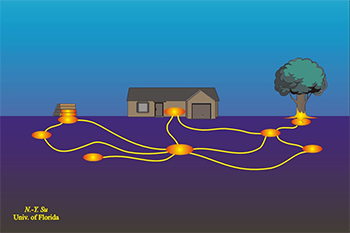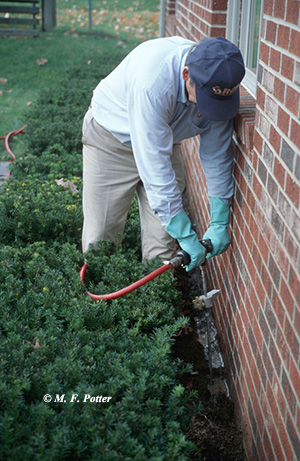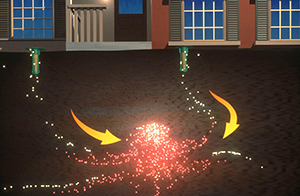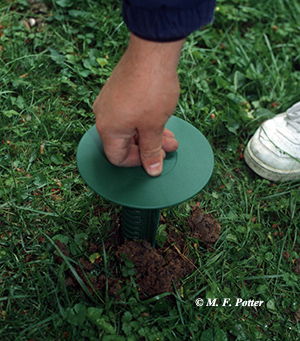Termite Baits: A Guide for Homeowners
ENTFACT-639: Termite Baits - A Guide for Homeowners | Download PDF
by Michael F. Potter, Extension Entomologist
University of Kentucky College of Agriculture
Termites might be a well-known pest, but not many people understand them, let alone the most current techniques to manage them. Termite control has evolved significantly in recent years, and many pest control firms are utilizing baits for treatment, versus traditional insecticide sprays. This publication will help consumers understand the various approaches, in order to make a more informed purchasing decision for pest management of termites.
TERMITE BASICS
Subterranean termites, the variety common to Kentucky and most other states, live below ground in cooperative, intermingling colonies. The colonies are decentralized entities occupying multiple nesting and feeding sites, interconnected by underground tunnels. Termite colonies can be quite large, consisting of hundreds of thousands to millions of individuals occupying areas of up to half an acre. Smaller colonies may contain fewer individuals, with a foraging footprint no bigger than a bedroom. In some cases, larger but fewer colonies may be present; in others, individual colonies may be smaller and more numerous. In residential settings, the termite colony or colonies responsible for inflicting damage may actually be located in a neighbor's yard, rather than around or beneath the house that is infested.

Fig. 1: Subterranean termites live underground in colonies.

Fig 2: Termites feed in multiple areas interconnected by underground tunnels.
Subterranean termites excavate narrow, meandering tunnels through soil, eventually encountering wood, their primary food. Decaying tree roots, logs, stumps, woodpiles, and plant debris afford a ready and abundant supply of food for the colony. In nature, the insects are beneficial since they aid in the decomposition of organic matter and the return of nutrients to the soil. Occasionally, however, foraging termites encounter wood or wood products (paper, cardboard, etc.) within buildings. Once they find a suitable feeding site, the workers establish an invisible odor trail to attract and guide their nest mates to the building.
Termite infestations can go undetected for years, hidden behind walls, floors, and obstructions. Their cryptic tendencies also pose challenges for control. Unlike other corrective services such as plumbing or electrical work, termite control involves living creatures. Traditional approaches may fail at times, underscoring the need for innovative forms of management.
BARRIER TREATMENTS
The traditional approach to controlling subterranean termites was to apply a liquid pesticide, known as a ‘termiticide,’ under and around the building. The purpose was to provide a long-lasting chemical ‘barrier’ in the soil to prevent termites from entering and infesting the structure. Foraging individuals attempting to penetrate treated soil were either killed or repelled while those already inside ultimately succumbed as well.

Fig. 3: Termites can also be controlled by treating the soil with a liquid termiticide.
Research has since shown that barrier products that are non-repellent and lethal to termites tend to be most reliable. Current examples include Termidor® /Taurus® (fipronil), Premise® (imidacloprid), and Altriset® (chlorantraniliprole). While such treatments are usually effective, large volumes of termiticide are applied around the perimeter of the building, accompanied by drilling/injection through adjacent porches and patios. Although today’s liquid barrier applications are less intrusive than in years past, some homeowners still find them objectionable.
THE BAIT ALTERNATIVE
Termite baiting employs a very different approach. With baits, small amounts of product are deployed like edible ‘smart missiles’ to knock out populations of termites foraging in and around the home. Termites consume the bait and share it with their nest mates, resulting in a gradual decline in termite numbers. A comprehensive baiting program then seeks to maintain a termite-free condition on the customer's property through ongoing inspection, monitoring and re-baiting as needed.

Fig. 4: Termite baits are capable of destroying entire colonies (Image: Dow AgroSciences).
Termite baits consist of cellulose (a structural component of wood), combined with a slow-acting insecticide which disrupts the normal growth process in termites. Within weeks of ingesting the bait, termites die while attempting to molt. The delayed action is important; if the bait killed quickly, sick or dead termites might accumulate near stations, increasing the chance of avoidance by other termites in the area. Delayed-action also enhances transmission of the lethal ingredient to nest mates, including those that never fed on the bait. Entire colonies can be eliminated in this manner, although colony elimination is not always necessary to afford structural protection.
Various baiting systems are being used by pest control firms, including Sentricon®, Exterra®, and Trelona Advance®. While there are some differences between the systems, all can be effective in controlling termites.
BAITING PROCEDURE
Termite baits are typically installed below ground around the entire perimeter of the building. With some systems, e.g., Sentricon, they may also be affixed indoors over active termite tunnels. Depending upon product and company protocol, inspection of stations may occur monthly, quarterly, biannually or annually. On some homes, baits constitute the only form of treatment; on others, they are supplemented with a partial liquid barrier application.
The bait station housing is a hollow plastic cylinder with slits along the sides for termites to enter. Termites tunnel through and out of the perforated tube, reuniting with their nest mates in the soil. In doing so, they leave behind a colony-specific scent that promotes recruitment of other termites to the station. Stations are inserted into augured holes in the ground, with the cover flush with the soil surface. Placement is usually about 1-2 feet from the foundation in order to avoid soil that may have been treated previously with another termiticide. Patios, driveways, and other paved surfaces are not problems unless access for installation of stations is prevented around the majority of the structure. Oftentimes, stations can be installed farther out from the foundation, in adjacent turf, landscaped areas, etc. If necessary, stations can also be installed directly through pavement.

Fig. 5: Inserting a termite bait station into the soil.
After installation, some or all of the stations are provisioned with bait. Termites cannot see or smell the baits in the soil; they more or less wander into them during their persistent foraging activities. To increase the odds of discovery, stations are installed at fixed intervals —typically 10 to 15 feet apart around the entire perimeter of the home. Additional stations are often placed in known or suspected areas of termite activity, such as around woodpiles, stumps, moist areas, and near previous termite damage. With patience and a little luck, the termites eventually find and feed on one or more of the installations.
One of the biggest challenges in baiting is getting termites to find the bait. The timetable for discovery varies from property to property, depending on the size, number, and foraging intensity of the colonies, which in turn is influenced by soil moisture and temperature/time of year. Because subterranean termites feed at multiple locations within their foraging area, chances are good that one or more bait stations will eventually be found and fed upon. In temperate climates such as in Kentucky, bait discovery will be greatest from spring through fall when termites are most active. Baiting during late-fall and winter is generally less productive. Termites may be found in belowground stations at sub-freezing temperatures, but their feeding activity and effects of the bait are reduced. At times of the year when ground is frozen, snow-covered, or saturated, inspection of stations can often be curtailed until conditions again become favorable for termite foraging and feeding. Bait discovery and feeding may also be reduced during periods of drought when termites often forage more deeply in search of moisture.
The more stations installed, the better the chances of locating termites. Patience and persistence are requisites for successfully using below-ground termite baits. Homeowners must be prepared and willing to accept the possibility of a lengthy baiting process.
CAN I DO THIS MYSELF?
Although some termite baits can be purchased online, the process requires diligence (Figure 6). Additional stations may need to be added if termites fail to find and consume the bait. If the problem persists, supplemental application of a liquid barrier termiticide may also be warranted. After the infestation has been eliminated, foraging termites from neighboring colonies may subsequently reinvade the area—necessitating that bait stations be periodically monitored and maintained. Ongoing surveillance of the stations (as well as the building itself) are important to ensure continued protection. For these reasons, termite baiting is usually a job most suited for professionals.

Fig. 6: Termite baits should be periodically monitored to ensure success.
BAITS OR BARRIERS: WHICH IS BETTER?
This is a common question from homeowners trying to decide which form of treatment to purchase. There is no simple answer. Factors to consider in the decision include:
- Are you opposed to having floors or porches drilled, or furnishings moved? Although today’s liquid barrier applications are less intrusive than in years past, some homeowners still find them objectionable. Customers considering bait treatment are usually relieved to learn that their floors won't have to be drilled or furnishings moved. The technician usually will not even need to come indoors to install or monitor the bait stations. Drilling, dust, and similar disturbances are avoided.
- Are you opposed to having pesticides applied around your home? Liquid barrier treatments utilize many gallons of termiticide, injected into the soil under and around the structure. While health and environmental effects from such treatments are usually considered negligible, some people remain apprehensive. With baits, the amount of pesticide used is miniscule, and the bait is confined below ground in tamper-resistant stations.
- Are there construction features that make it hard to treat with a liquid? Some buildings have wells, cisterns, nearby ponds or streams, plenums, sub-slab heating ducts, drainage systems, inaccessible crawl spaces, or other features that complicate treatment of soil with a liquid. With baits, such conditions aren't a problem and may be the only feasible form of treatment. Houses that were unsuccessfully treated with liquids also are candidates for baits, since they do not require gaining access to hidden or hard-to-reach areas.
- How quickly must the infestation be eliminated? A limitation of all termite baits is that they are relatively slow-acting compared to the effects of liquids. Weeks or months may pass before termites find the baits underground and distribute them to their nest mates. Thus, the elimination process can take several months or longer to complete, and a degree of feeding and damage may occur before the bait takes effect. Homeowners with a severe termite infestation or those involved in a real estate transaction may not want to wait this long — preferring instead that a liquid be applied alone or in combination with baits.
- How much are you willing to spend for treatment? Termite services vary in price depending on such factors as perimeter dimension of the home, construction type, and area of the country. Baiting can sometimes be costlier than a liquid treatment because more visits may be required to monitor for termites, and add or replenish baits. Homeowners should consider both the initial treatment cost and the annual renewal fee in making their purchasing decision. Failure to maintain the annual renewal agreement with baits poses additional risks, since there is no residual pesticide left in the soil after the termites have been eliminated. Ongoing structural protection depends on retaining the stations in the soil and periodically monitoring them for the possible return of termites.
In summary, baits are useful and effective tools for managing termite infestations. Regardless of which product/system is used, they will not work by simply hammering some stations into the ground and walking away. Success requires thoughtful installation and diligent monitoring by an experienced technician, backed by a responsible pest control firm.
For further information about the products mentioned in this publication, contact your local termite control professional, state agency responsible for pesticide regulation, or university cooperative extension office in your area. Where trade names are used, no endorsement is intended, nor criticism implied of similar products not named. For more about termite management and prevention, see our other entomology extension publications, Entfact 604: Termite Control: Answers for Homeowners, and Entfact 605: Protecting your Home from Termites.
Revised 9/5/2018
CAUTION: Some pesticides mentioned in this publication may not be legal in your area of the country. If in doubt, please consult your local cooperative extension service or regulatory agency. Furthermore, ALWAYS READ AND FOLLOW LABEL DIRECTIONS FOR THE PRODUCT YOU ARE USING.
Please note that content and photos in this publication are copyrighted material and may not be copied or downloaded without permission of the Department of Entomology, University of Kentucky.
